
Gaining muscle and losing fat requires precision engineering. It should come as no surprise then that the Germans — who brought us the diesel, engine, electron microscope, and Heidi Klum — pioneered it.
According to legend, during the Cold War, an Eastern Bloc scientist defected to West Germany, where he conducted experiments on weight training for body recomposition. His team found that pairing upper- and lower-body exercises, performing moderate rep ranges, and limiting rest between sets led to increases in muscle size and fat loss. This kind of training has come to be called German Body Comp (GBC), and it’s a primary go-to template for trainers who need to whip clients into shape fast.

Men’s Health
Order Now
For a full compendium of fitness knowledge, check out the Men’s Health Encyclopedia of Muscle. The volume is chock full of workout routines, helpful training tips, and definitions for just about every gym-related term you’ve ever wanted to know.
How To Train Like the Germans

Getty ImagesIbrakovic
The exercise pairs you select will usually work the lower and upper body in turn, or otherwise be non-competing — that is, one exercise won’t negatively impact your performance on the other.
“Going from a lower-body movement to an upper-body movement allows one area to recover while the other works,” says Joe Dowdell, a personal trainer in New York City. “So you’re able to get quite a bit more work done than if you just do straight sets of one exercise at a time.”
For example, you could alternate a squat with a pressing exercise. This kind of pairing also places extra demand on your heart: blood runs to your lower body in the squat and then must rush back up to the chest and arms during the press, and that increases the cardiovascular effect and calorie burn of the workout. Another example of non-competing lifts would be a pair of shoulder and biceps exercises, or biceps and triceps.
The reps should be done in the 10 to 15 range, with a rest period after the first exercise and then again after the second — both in the range of 30 to 75 seconds. “I might start out with 60 seconds after the first lift and 60 after the second and drop it down to 30/60 over a couple weeks,” says Dowdell. To better customize your recovery between rounds, Dowdell suggests using a heart-rate monitor and waiting until your heart rate drops to 60 to 65 percent of your max. Use the following formula to estimate your max heart rate: 207 – (0.7 x your age). Do three pairings like this in the workout and perform two to four total rounds per pair.
Push Your Protocol Even Harder

Getty ImagesWestend61
That’s the classic GBC protocol and it works just fine, but Dowdell says if you want to take it to the next level, you can add a burst of high-intensity cardio after the pair of lifts. This could be sprinting on a fan bike, Versaclimber, or rower, or skipping rope. “That works really well for creating a tremendous amount of caloric expenditure during the workout,” says Dowdell. Whatever cardio you choose, it shouldn’t be overly technical, as you need to be able to perform it safely in a fatigued state.
For example, pedaling all-out on an Airdyne bike is a better choice than sprinting down a track, as running mechanics will likely be thrown off by the fatigue you built up doing the two lifts prior. The cardio should be done at the hardest pace you can maintain for 30–60 seconds.
Dowdell likes to throw another twist into GBC with the use of tempos on the lifts. By slowing down your reps, you’ll keep better form and extend the length of time your muscles spend under the tension of the exercise, which is a stimulus for growth.
Tempo is prescribed with four digits: the first is the number of seconds you should take to perform the lowering portion of the exercise. The second is the length of time you should pause in the bottom position. The third is the time you should use to lift the weight, and the fourth is the length of the pause at the end position. A “0” means no time; move on to the next number. For example, a tempo of 2010 on a squat means to take two seconds to lower your body and then immediately take one second to come up. Dowdell favors tempos of 2110, 3010, or 2020.
GBC can be performed three days per week (take a day off lifting in between GBC workouts) for four to six weeks. Beginners can perform the same workout each session, while more experienced lifters should follow an A-B split. That is, have two workouts, a Workout A and Workout B, and alternate them for three sessions per week. So in Week 1 you could do A on Monday, B on Wednesday, and A again Friday. Then in Week 2 you’d do B on Monday, A on Wednesday, and B again Friday.
The German Body Comp EoM Workout

Getty ImagesIbrakovic
For a taste of GBC, try this sample routine from the Men’s Health Encyclopedia of Muscle. Alternate sets of the paired exercises (marked “A” and “B”). So you’ll do one set of A, rest, then one set of B, rest again, and repeat until all sets are complete for the pair; then move on to the next pair.
Perform 3 to 4 sets of 10 to 12 reps for each pairing. Use a 2020 tempo for each as well. Rest 60 seconds after the first exercise in each pair and rest until your heart rate recovers to 60 to 65 percent of your max heart rate after the second exercise. If you don’t have a heart rate monitor, rest up to 75 seconds, maximum.
If you like, perform 30 to 60 seconds of high-intensity cardio after the second exercise in each pairing. For example, do battle rope slams after the neutral-grip bench press, inverted row, and hammer curl. Then follow the same rest protocol as outlined above before repeating.
1A Front Squat

Mitch Mandel
Set a barbell in a power rack at about shoulder height. Grasp the bar with hands at shoulder width and raise your elbows until your upper arms are parallel to the floor. Take the bar out of the rack and let it rest on your fingertips—as long as your elbows point forward, you’ll be able to balance the bar. Step back and set your feet between hip and shoulder width with toes turned out slightly. Take a deep breath and squat as low as you can while keeping your head, spine, and pelvis aligned. Take two seconds to lower your body and two seconds to come up on each rep.
1B Neutral-Grip Dumbbell Bench Press
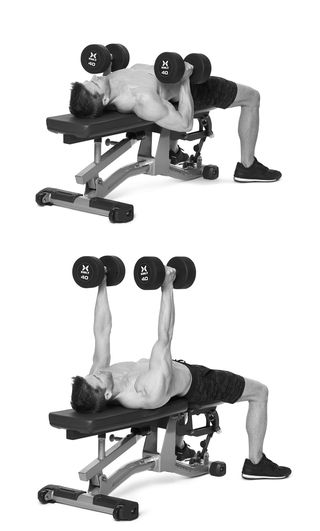
Mitch Mandel
Lie back against a flat bench with a dumbbell in each hand, palms facing each other and elbows tucked close to your sides. Press the dumbbells from shoulder level to overhead. Take two seconds to lower the weights and two seconds to press them on each rep.
OPTIONAL: 1C Battle Rope Slam
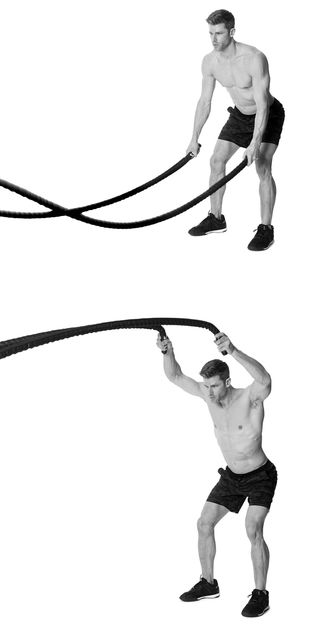
Mitch Mandel
Wrap a battle rope around a secure anchor point and stand back until the lengths of rope are extended but slack enough so each end can measure up to your waist from the floor. Take an athletic stance and brace your core. Whip the ropes into the floor as fast and as hard as possible.
2A Romanian Deadlift

Mitch Mandel
Place a barbell on a rack set to hip level. Grasp the bar with hands at shoulder width and pull the bar out of the rack. Step back and set your feet at hip width. Take a deep breath and bend your hips back while keeping your head, spine, and pelvis aligned. Allow your knees to bend as needed, and go until you feel a stretch in your hamstrings. On the way up, squeeze your glutes and return to a standing tall position. Take two seconds to bend your hips back and two seconds to extend them on each rep.
2B Inverted Row
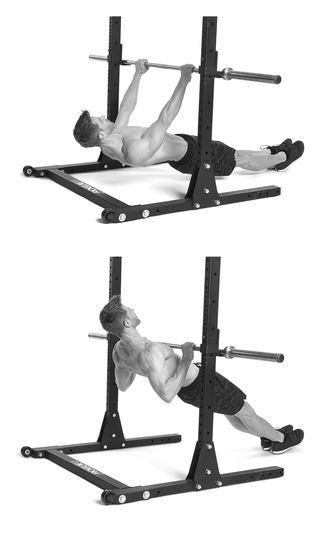
Mitch Mandel
Grasp onto a bar, rings, or other sturdy object that’s set to about hip level. Your hands should be shoulder-width apart. Walk your legs forward and hang from the bar so your body forms a straight line. Draw your ribs down and brace your core. Pull your body up to the bar until your back is fully contracted. Tuck your elbows close to your sides as you pull. Take two seconds to pull yourself up and two seconds to lower your body on each rep.
OPTIONAL: 2C Battle Rope Slam
See 1C above for instructions.
3A Seated Dumbbell Overhead Press
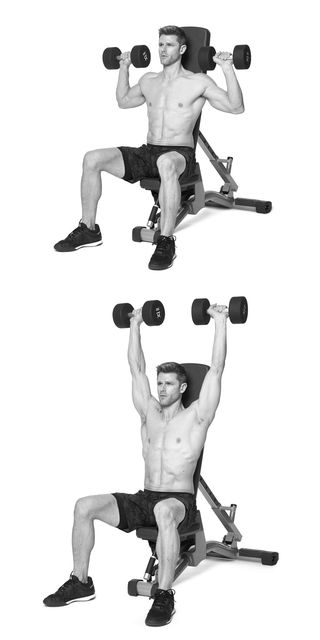
Mitch Mandel
Raise the back of an adjustable bench to 90 degrees and sit on the seat so your back is supported. Grasp a dumbbell in each hand and hold them at shoulder level. Keeping your core braced (think: ribs down), press the weights straight overhead. Take two seconds to press and two seconds to lower each rep.
3B Seated Hammer Curl
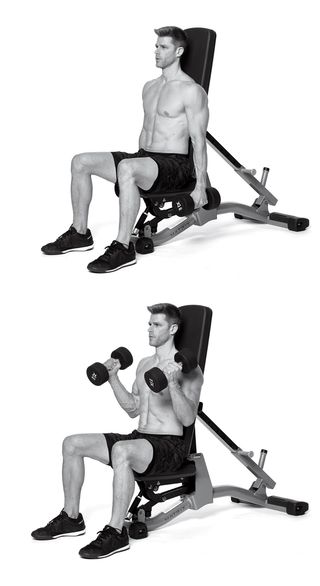
Mitch Mandel
Stay on the bench you used for the overhead press. Grasp a dumbbell in each hand. Keeping your upper arms stationary, curl the weights with palms facing in. Take two seconds to lift and two seconds to lower on each rep.
OPTIONAL: 3C Battle Rope Slam
See above.
4 Plank
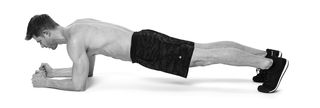
Mitch Mandel
- Sets: 3 to 4
- Reps: Hold for 60 sec.
- Rest: 60 sec. (or 60 to 65 percent of max heart rate)
Get into pushup position and then bend your elbows to lower your forearms to the floor. Hold your body in a straight line with your core braced. Note that there is no tempo for planks.
Source: Read Full Article
